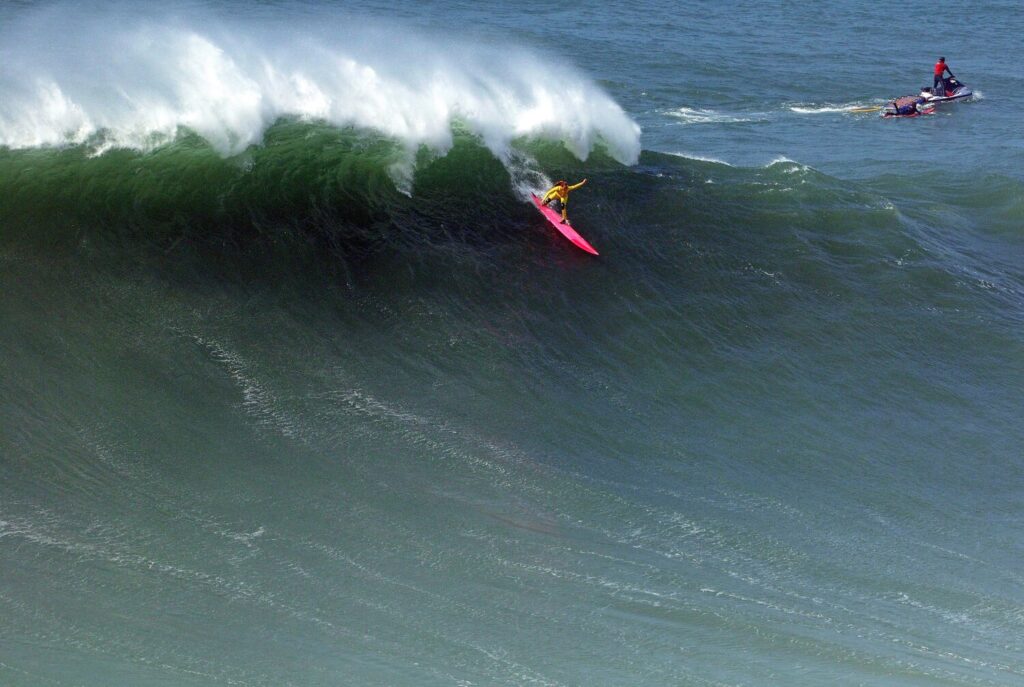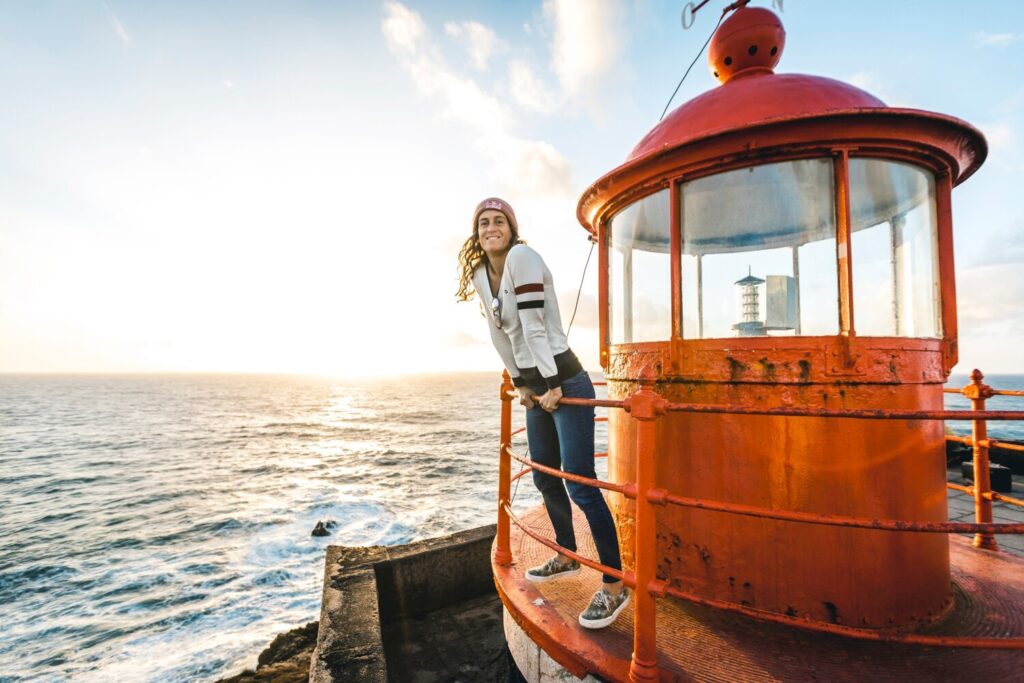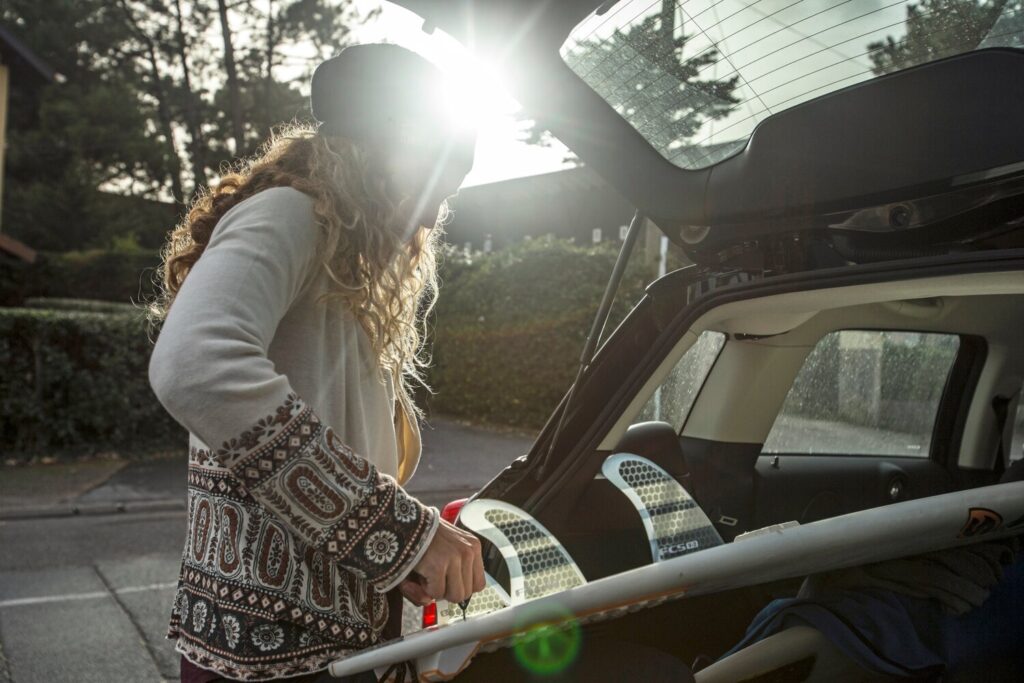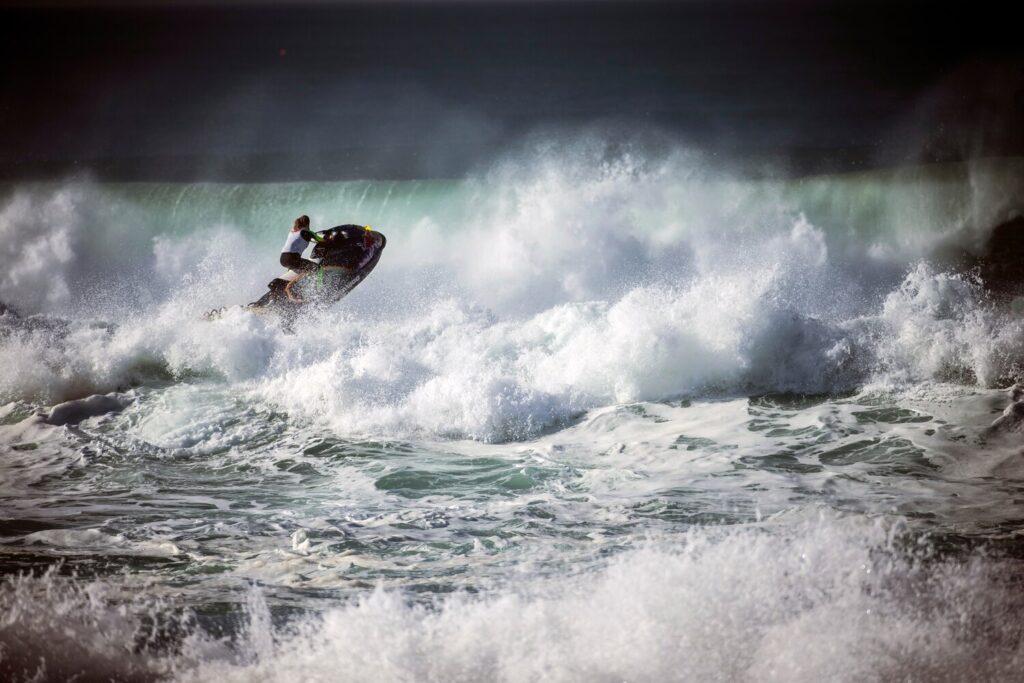Home Interview The BASE Interview #04: Justine Dupont
The BASE Interview #04: Justine Dupont
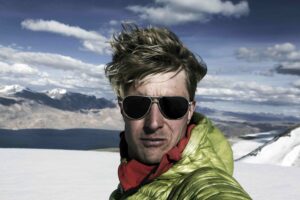
Justine Dupont is one of the world’s leading surfers, and a well known figure amongst the international big wave surfing contingent. She began wave riding as a teenager on the Atlantic coast of southwest France, quickly progressing to become the longboard vice world champion in 2007 at the age of sixteen. She spent a decade in professional competitive surfing, winning multiple titles, and in 2019 she won two trophies at the XXL Big Wave Awards, confirming her reputation as one of the most accomplished big waves surfers in the world. She’s a regular at many of the world’s most powerful and legendary waves including Jaws in Hawaii and Praia do Norte at Nazaré, Portugal. In early 2021, she pulled into what may be the biggest barrel ever ridden by a woman during an all time session at Jaws. She now lives in Seignosse in the far southwest of France, close by the world famous beach breaks of Hossegor. BASE recently spoke to Justine about her passion for big wave surfing, the highs, lows and in-betweens of the lifestyle of a professional surfer, and the benefits of trampolining as an off-day activity.
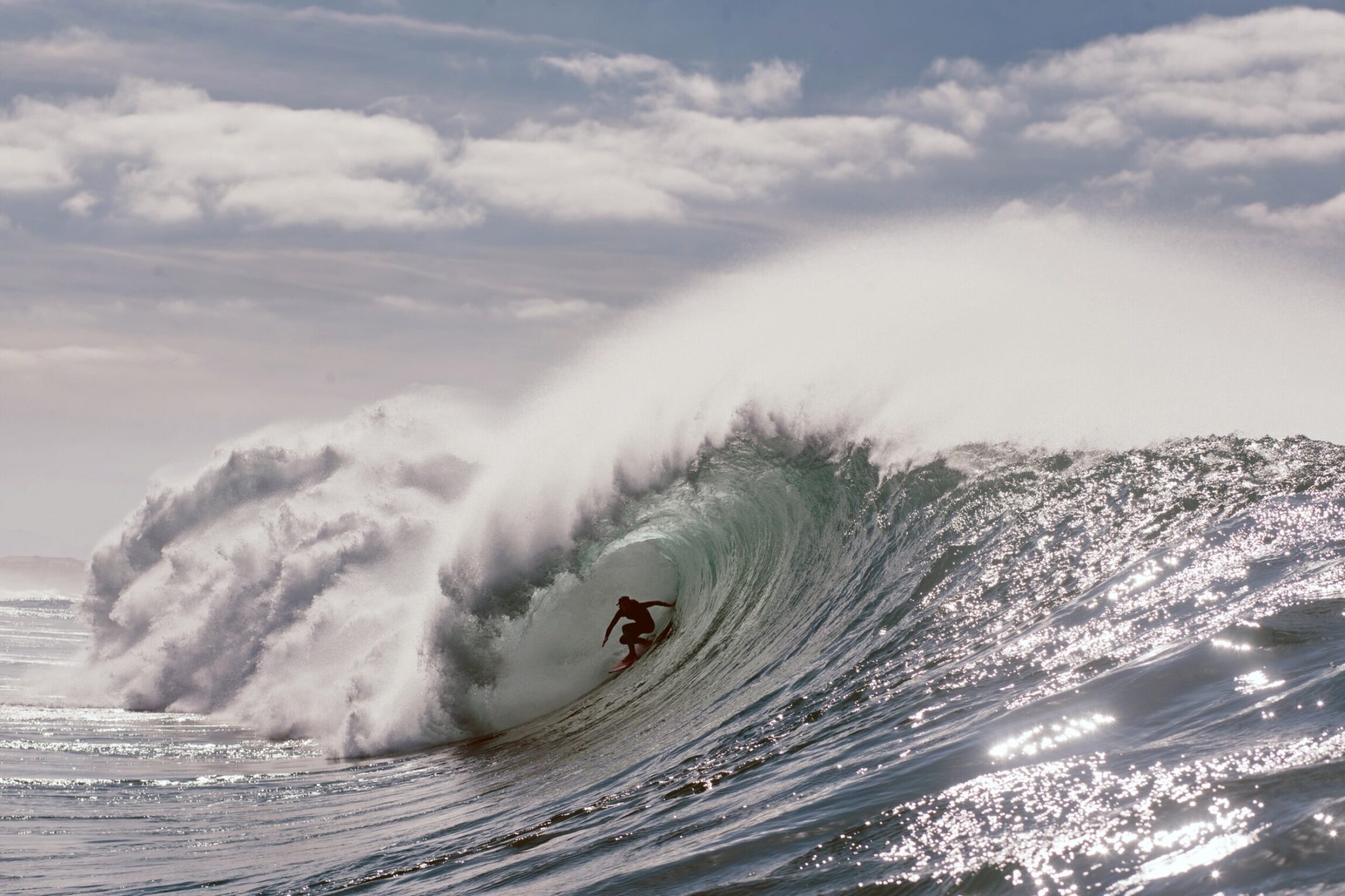
Justine navigates her way through a perfect heavy Hossegor barrel, the most renowned surf town on France’s Atlantic coast. © Bastien Bonnarme / Red Bull
Do you remember the first wave you ever rode?
For sure I do! It was a little left in the rip current at Lacanau on the west coast of France, I was maybe 9 or 10-years-old. It was a big day but I was surfing the smaller waves in the rip before the big line up. I was with my dad and brother – all my very first days surfing were with them.
Was surfing a case of love at first sight, or did you grow into it as you improved?
I was doing other watersports at the time, but as soon as I started surfing I just knew I wanted to do it more and more. On that day at Lacanau, I knew that surfing would be a big part of my life.
When did you first realise you wanted to pursue a career as a pro?
I think I actually worked this out pretty late, as many pro surfers start very young these days. At around 15, I went to a high school where you’re allowed to surf during the afternoon, so I could improve my technique and skill all the time. But around 16 or 17, I realised I was good enough to become a pro surfer. Lacanau is a good surfing town but it’s not as famous as some other places in France, like Hossegor or Biarritz for example. Growing up in Lacanau, surfing was just for pleasure, there wasn’t a sense of surfing being something you did for work or to get involved with marketing for big companies.
You became the longboard vice world champ in 2007, was that a pivotal moment in your early surfing career?
Oh for sure, definitely. It was also the first time I had to speak English in a formal context! That was a bit intimidating [laughs]. And after this I got a lot more opportunities for sponsorship, and I quickly became more interested in the possibility of pursuing a career in surfing as a professional.
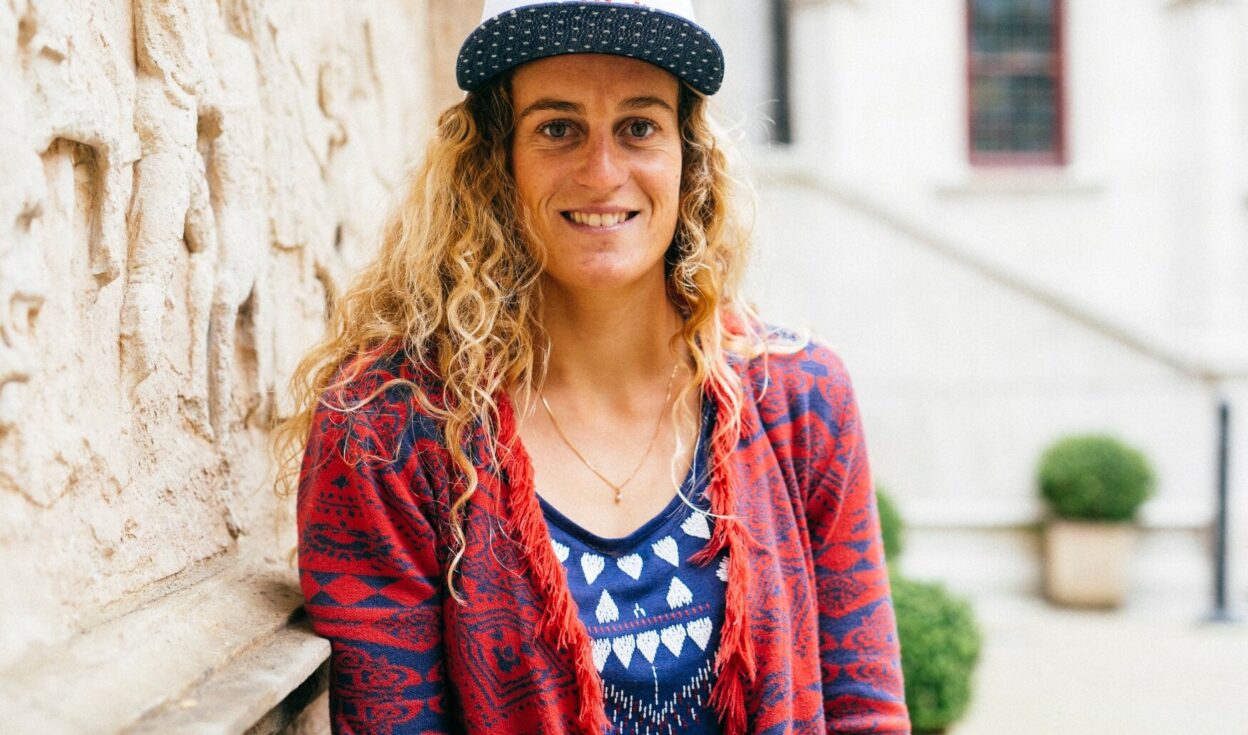
Justine at home in Seignosse, France © Teddy Morellec / Red Bull
In 2013, you became the first woman in the world to surf the legendary Belharra wave in the Basque Country. What was that like?
Yes, just a few months before this I’d surfed Aileen’s in Ireland, another big wave and my first experience of big wave surfing. I really enjoyed that, and the whole experience of going on a trip with other big wave surfers from France. After Belharra, I really wanted to do more, even though the first day I surfed Belharra it wasn’t actually a big, consistent day.
Was the Belharra the starting point for your move into big wave surfing?
Yes it was. I had already surfed Lacanau when it was really big, and Hossegor, Seignosse, as well. I felt like okay, so I’ve surfed the biggest waves in France and I really liked it. So that was it… I was hooked on big wave surfing by then!
Big wave surfing is a unique discipline within the broader sport. What are the main differences between big wave surfing and regular surfing?
The key thing is the whole strategy of surfing as a team – it’s the surfer plus their safety team, not just the surfer on their own as it is with regular surfing. Having people with you who are also responsible for your safety, because even if you paddle out for big wave surfing, you still need a safety buddy on a jet ski. The team aspect is actually one of the things about big wave surfing I like the most. The other aspect is the feeling of complete freedom you have when riding big waves, because there’s nobody else around you as there is a regular line-up. It’s just you and the ocean. I also love the feeling of following the swell and the forecast, and I enjoy the adventurous side of it too. There’s a lot of planning and preparation required to successfully surf big waves.
Does tow surfing completely change the nature of what you’re doing as a surfer?
For sure it changes many things. With a tow-in you have a lot of choice about which line to take, and you can often catch the wave much earlier than you can normally as you have that extra speed well before the wave’s even breaking. You can enjoy the feeling of riding the swell itself and you really have this feeling of freedom on the wave, of being able to go where you want.
How intimidating is it being towed into a massive Atlantic swell at Nazaré? What do you feel like when you let go of the tow line, and you’re alone on the wave?
It’s a feeling of complete freedom, to go where you want, and being alive on the ocean. I have complete confidence with my team, and my boyfriend Fred, who rides the ski and is my regular tow-in buddy for big wave surfing. He’s a very good surfer too, and I trust the choices he makes about which wave to put me on, and I trust myself to then catch the wave correctly and to take the right line. Trust is very, very important in big wave surfing! I like the feeling of once you let go, it’s your responsibility and only you are responsible for the outcome. You just have to stick to your instinct and the feeling of surfing and trusting in what you’re doing out there.
Maybe I get a little apprehensive or nervous if my feet are not properly attached to my footstraps, but really there’s no time to feel afraid. Also you can be afraid if you feel the line you’ve taken isn’t the best one and you’re in the wrong spot. Sometimes afterwards when you see the footage you can be like ‘oh my god, it could have been worse if I’d taken that line!’ But there’s not much time for thinking when you’re going so fast on a really big wave. In that moment, you are living the moment on that wave; it’s sensation, not emotion.
Is the capacity to deal with the unknown important for a big wave surfer?
Yeah, for sure it is. You need to be able to adapt all the time. [On a lefthander] I ride backside to the wave, which makes it tricky as you can’t see the wave breaking behind you. You’re facing away from where the wave is breaking. So you have to trust your feelings and have a sense of magic connection to the ocean.
What’s the main attraction of big wave surfing for you personally?
It’s all about you and your relationship with the ocean, and not about you in relation to others. I was competing for around 10 years, and I had to do all the stuff you have to do in professional competitive surfing. With big wave surfing, it’s about me and my feelings, you have a much bigger connection with the ocean, and you learn much more about surfing and about yourself too.
You’ve talked about the way you have nothing but your own instincts to assess your speed on a big wave. Getting this right is clearly critical, as speed determines your position on the wave. Can you explain this idea a bit more?
Okay, so it’s instinctive because you don’t think and the wave is big enough to be dangerous. Even in smaller conditions on a point break you have to make those decisions. You have to be able to make decisions very quickly when surfing, and experience is crucial to making those right decisions.
Big wave surfing is all about you and your relationship to the ocean, and not about you in relation to others
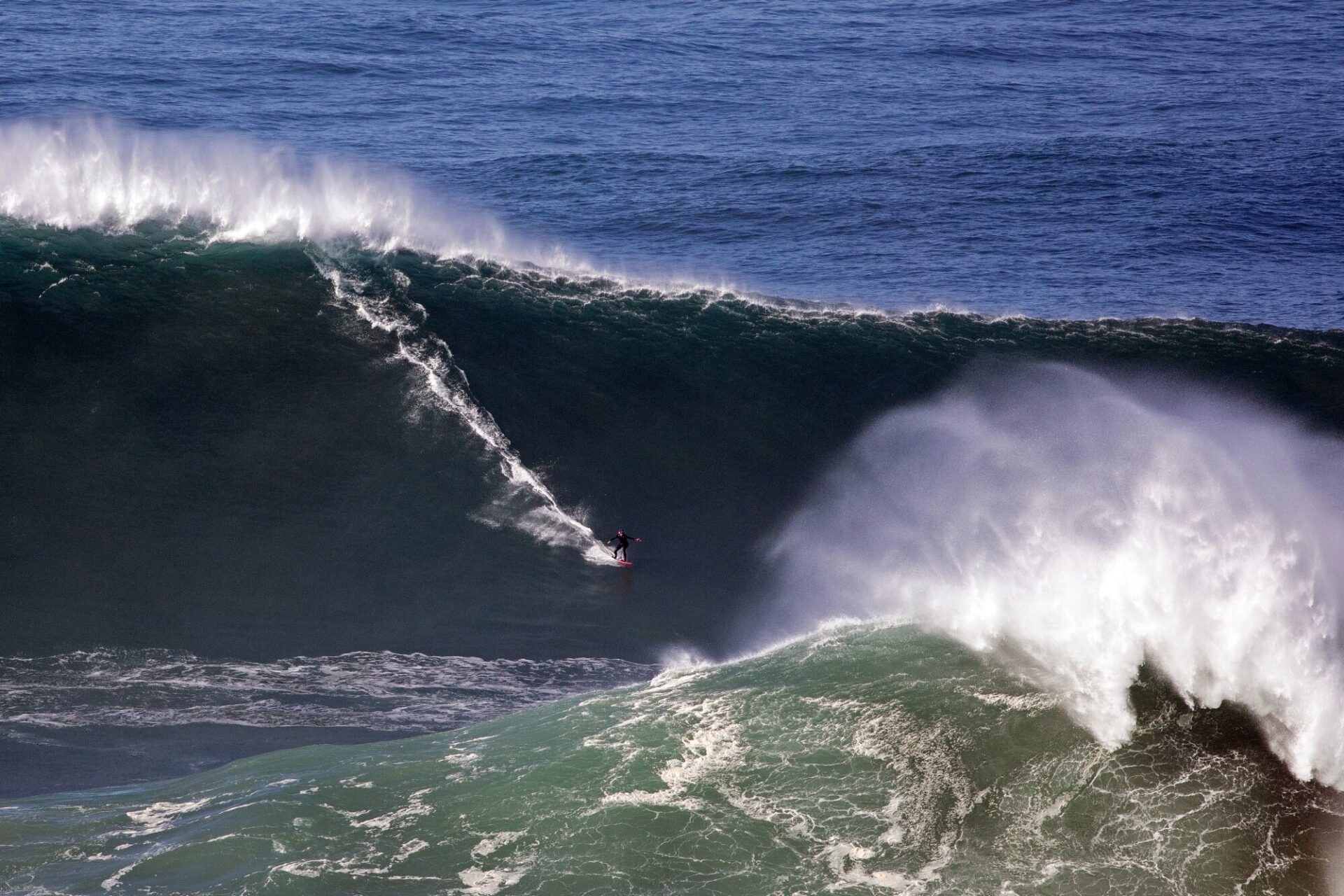
Justine charging during the first winter swell at Praia do Norte, Portugal, in October 2020. © Hugo Silva / Red Bull
You are one of a very few women in the world to have ridden these truly massive waves at Nazaré and Jaws. Do you feel that as you and other women push the boundaries of female big wave riding more women will follow in your footsteps?
Oh for sure, we are just at the start really. We will see more technical surfers coming from the competition arena and moving into bigger waves. There are already young surfers doing turns that nobody else can do, and I’m sure some of them will eventually transfer those amazing skills into a big wave surfing context. We’re just at the beginning for women in big wave surfing!
The consequences of big wave surfing are far greater than surfing in small waves, but is it possible to control those risks?
I think you can. For me, the style of big wave surfing is improving quickly, and also the safety aspect is improving very fast as well. For example, this year I will have another friend working in my safety team, so I’ll have a team of three rather than two. These guys are all professional lifeguards and I trust them all completely, which is very important. Of course, the size and the power of the waves mean that an error can be much more serious than in regular surfing, but if you are really drawn to big wave surfing then you should definitely go for it. You can control the risk a bit if you know what you’re doing. Also this year I’m using a helmet!
Have you done any foil surfing [where an underwater aero wing is connected to the board lifting it and he surfer above the water]?
Yes, I have. It’s really interesting, it’s incredibly good physically. Foiling is just amazingly good training both for your legs and for the cardio fitness. You’re often riding a wave for much, much longer than you would ordinarily and so the physical demands are very high.
What’s the worst wipeout you’ve ever had on a wave?
About two years ago, I was paddling into the lineup at Jaws in Hawaii, it was a huge swell that was increasing during the day. On one set I was too close to the shore and the wave broke on top of me. I dislocated my shoulder and broke my knee pretty badly. I also perforated my eardrum on another occasion!
Have you ever been in a situation where you felt you might drown?
No. Not at all. Because when you’re surfing your instincts tell you what to do. That time at Jaws when I dislocated my shoulder, I had to go down to the bottom because I knew another wave was going to break on top of me, after the one that hurt me. When I popped up I had trouble seeing because everything was white, there was foam everywhere. I knew I was hurt, and that another wave was coming, so I knew I had to breathe deeply before going back down to the bottom again. I didn’t feel fear, I just knew I had to go down and wait. When I popped up again, one of my safety team came over with the ski to pick me up.
What are your favourite places to surf around the world?
Nazaré and Jaws. I was supposed to be in Hawaii this week but because of Covid I couldn’t make it! I love that wave. I really want to go to Tahiti, to surf Teahupo’o [one of the world’s heaviest waves]. And also my local spots in the south of France like Hossegor, and also Mullaghmore in Ireland – that is one hell of a wave!
To surf at a high level, to do anything at a high level, you have to want it really deep inside
Does cold water surfing in places like Norway or Iceland appeal to you?
Yes definitely, the adventure travel side of this kind of surfing really appeals to me. And because you will have less people in the line up, and more passionate people. When the water is super cold, you have to be passionate to get in the sea at all!
You are the chair of the ISA athlete’s commission for the 2021 Olympics. Is contributing to the development of surfing as a professional sport important to you personally?
Yes, definitely, and it’s good for surfing to be in the Olympics, it brings in more money to the sport in the form of sponsorship, and gives people more opportunities to travel and to train. The Federation [ISA] is doing a really great job actually of promoting surfing as a more mainstream sport.
Do you feel strongly about supporting strong young women surfers, and giving them confidence to enter the sport as professionals?
Oh, for sure I do. But I don’t see myself as a role model just for girls or women. It doesn’t matter to me whether I inspire girls or boys, what matters to me is that people see something I’ve done and it makes them want to go surfing.
Surfing has been described as a sport with an inherently macho culture. Is that something you’ve had to deal with in the course of your career?
Surfing definitely does have a culture of ‘bigger is better’ and there is a macho element in that, of course. But the important thing is to be well surrounded, to have a really great group of friends and partners who you surf with. It’s about having the right community, a community with values that you also share.
What advice would you give to talented youngsters who want to pursue a career in surfing?
They should ask themselves what they really want deep inside. To surf at a high level, to do anything at a high level, you have to want it really deep inside. You have to spend a lot of time in the water– so much time – so it has to be a huge part of your life. But if you’re truly passionate about it, that won’t matter. You also have to be happy to be travelling a lot of the time, and not be scared to spend many months of the year away. But these days you don’t actually have to be the best to make a career out of surfing. If you’re good with video and photography, if you’re a good storyteller, and maybe go to places that other surfers don’t go, then you can build a successful career in surfing without being the very best surfer in the world.
What’s the most perfect wave you’ve ever ridden?
Oh I know exactly. It was in Nazaré in February 2020. The shape of the wave that day was just crazy. It was huge and peaky yet really smooth and glassy at the same time, I did a turn in the barrel and rode right out to the end of the wave. It was an absolutely unbelievable wave.
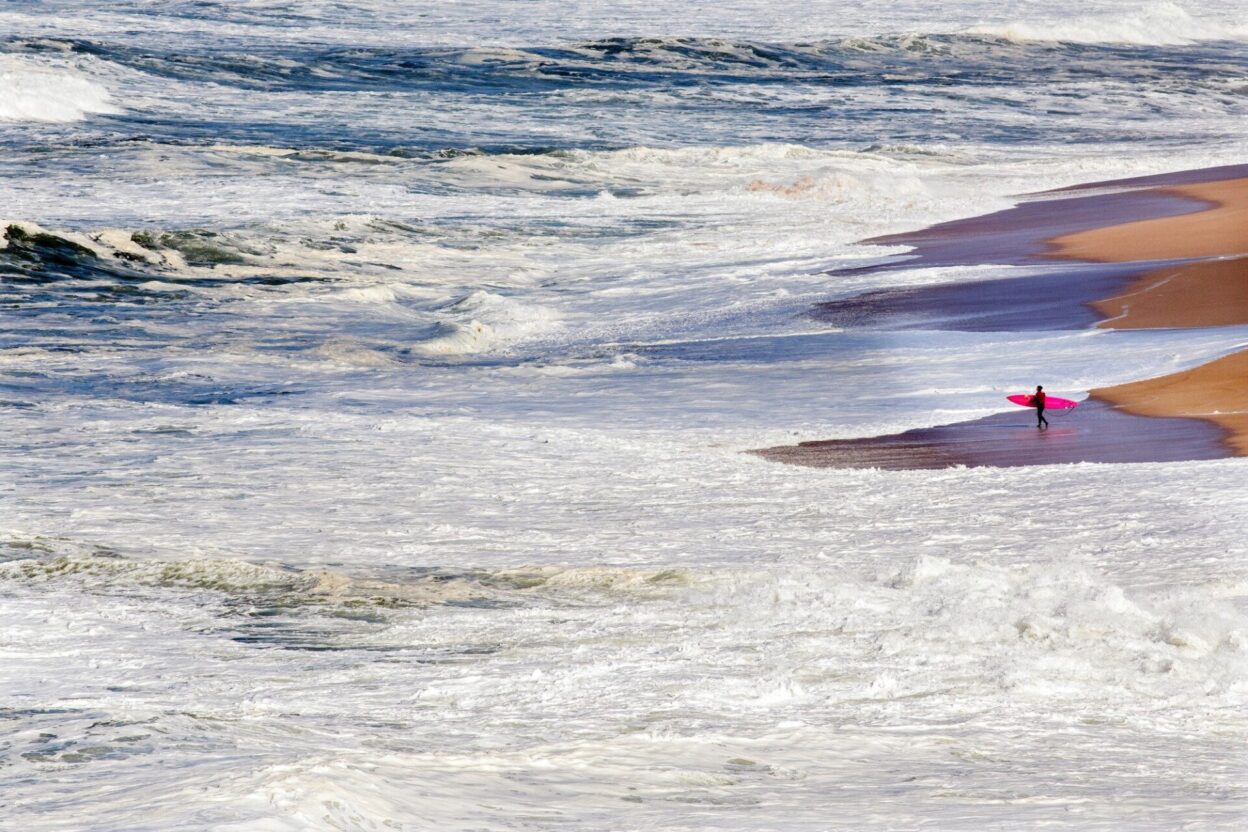
Justine looking for a rip to paddle out between the huge waves of Praia do Norte, Nazaré © Hugo Silva / Red Bull
How important is the adventurous aspect of surfing for you – all the travelling to new and sometimes very remote places?
I would say that adventurous travel is important, but also being an open and adventurous person is also important. You need to be able to speak with people who are doing different things and be open to new ideas. This is the adventure of today, rather the adventure of yesterday. Adventure is also about being new, about looking to the future.
What do you feel the future holds for big wave surfing as a sport?
In the short term, many new areas will be explored all over the world, that’s for sure. And the other thing that will happen – and is happening – is more freestyle riding techniques will be applied to bigger and bigger waves, stuff like snowboard tricks, 360s, 720s, you name it!
What other sports to you do and why?
I do a little bit of trampolining, it really helps my surfing. I also do some skateboarding, which is a very good complement to surfing. I also do some running and pilates, which also helps keep the body in really good condition.
What’s the best thing about living the life you lead?
The best thing is also the worst thing at the same time; to have your plans challenged and changed almost every day because of what the weather and the ocean is doing. As a professional surfer, you have to live determined by these huge natural forces of winds and swells that are totally outside of your control. When I tell my family I’m going to be there with them for Christmas, I really can’t know I will be for sure as if the forecast changes and there’s a huge swell, I might have to go to Hawaii for example. As a surfer, nature dictates what you’re going to do day-by-day, and every day is different and unpredictable. This can be hard to understand for other people in your life. It does help if your family or partner understands that you’ve chosen this life, and why you’ve chosen it.
Don’t miss a single adventure
Sign up to our free newsletter and get a weekly BASE hit to your inbox
Other posts by this author
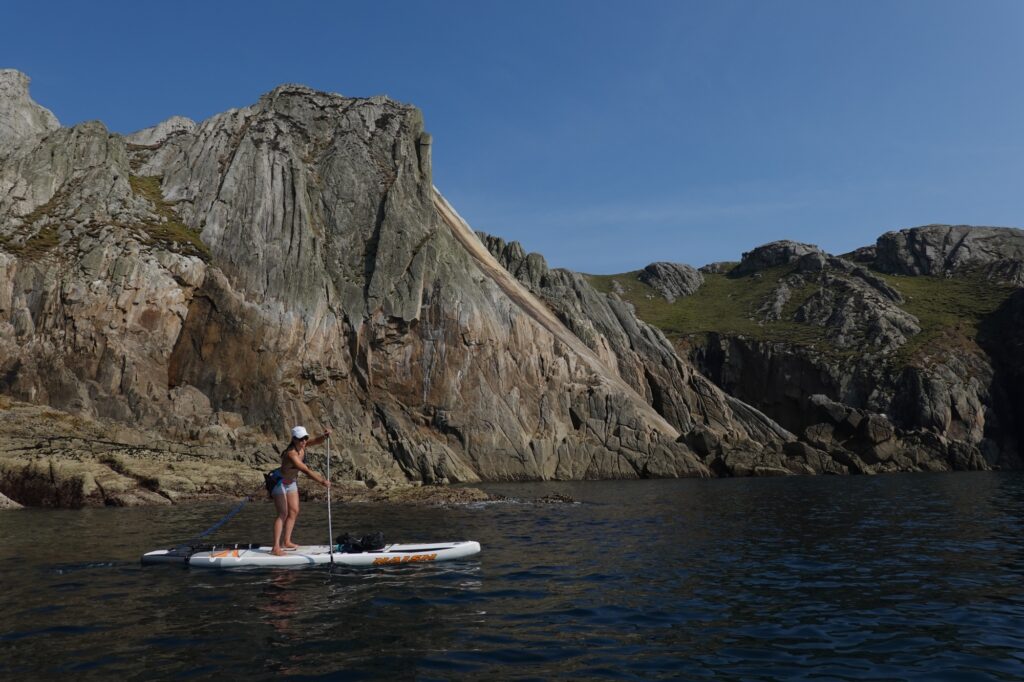
Story • David Pickford • Apr 12, 2023
West by Northwest: Lundy Island by Standup Paddleboard
An open-water SUP voyage from the north coast of Devon to the iconic island of Lundy
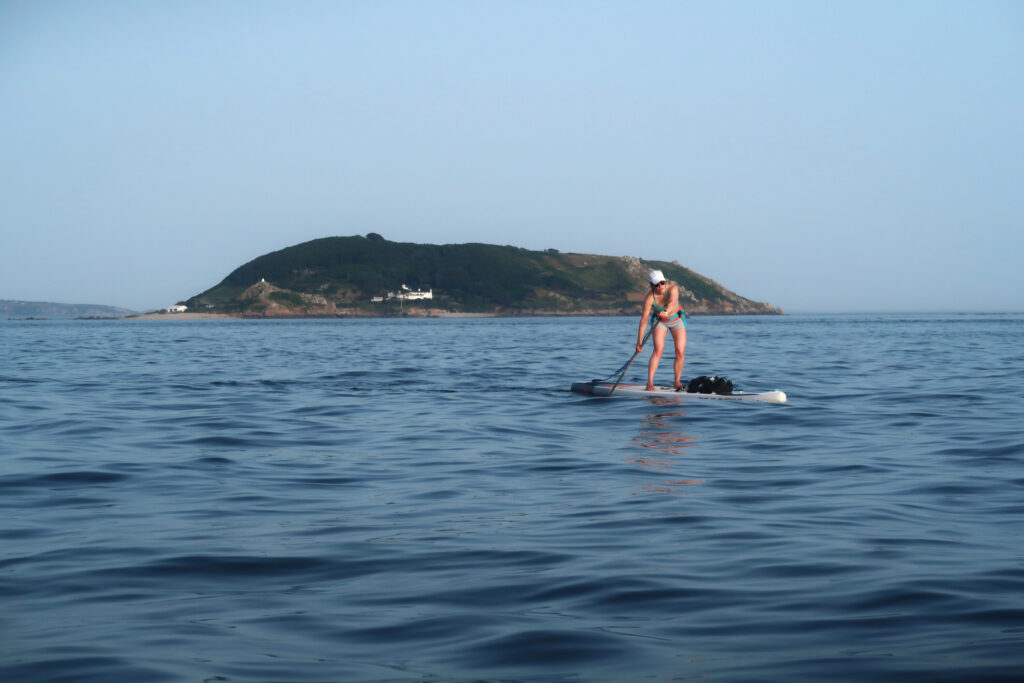
Story • David Pickford • Jul 24, 2022
Vectors in the Stream
A voyage between islands across some of the world’s strongest offshore tides
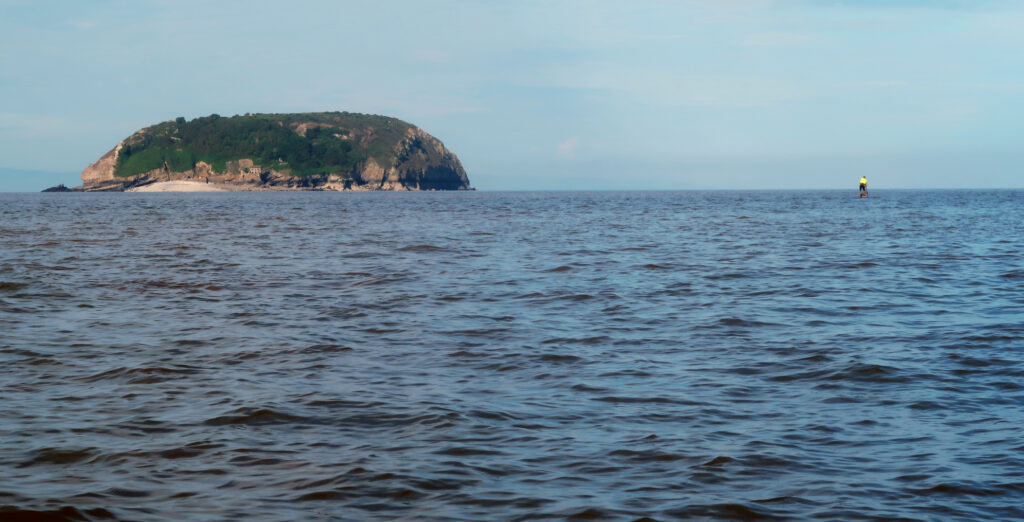
Story • David Pickford • Feb 04, 2022
Tidelands
Travels in the unexpected wilderness of the Bristol Channel
You might also like
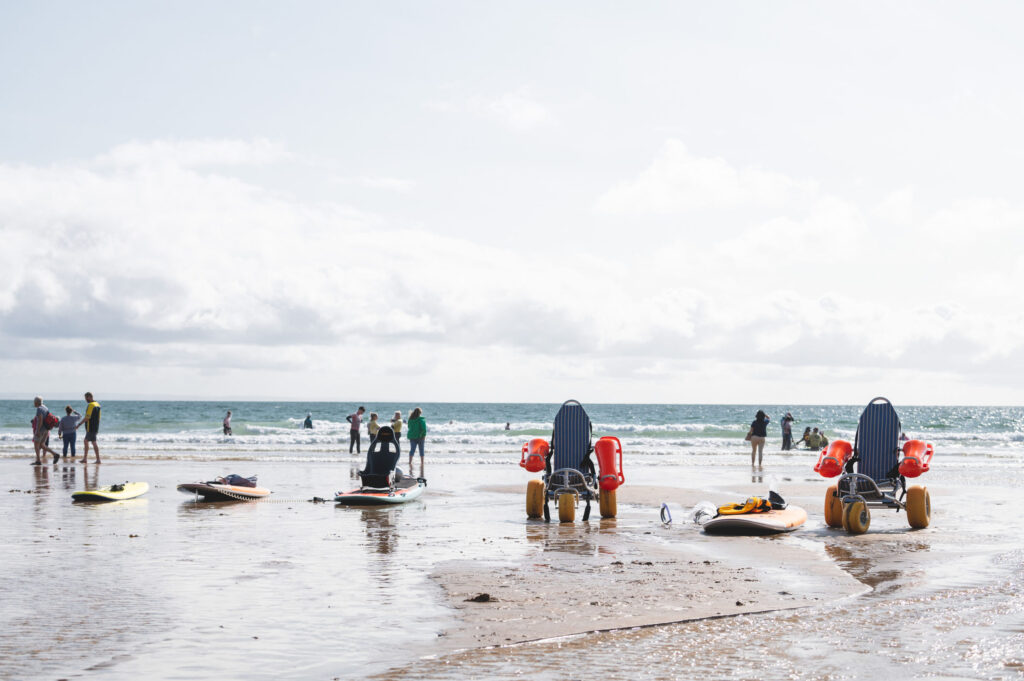
Story • Hannah Dines • Mar 01, 2023
Let My Disabled People Go Surfing
How do we ensure our coastlines are accessible to all? Para athlete and adaptive surfer, Hannah Dines finds out
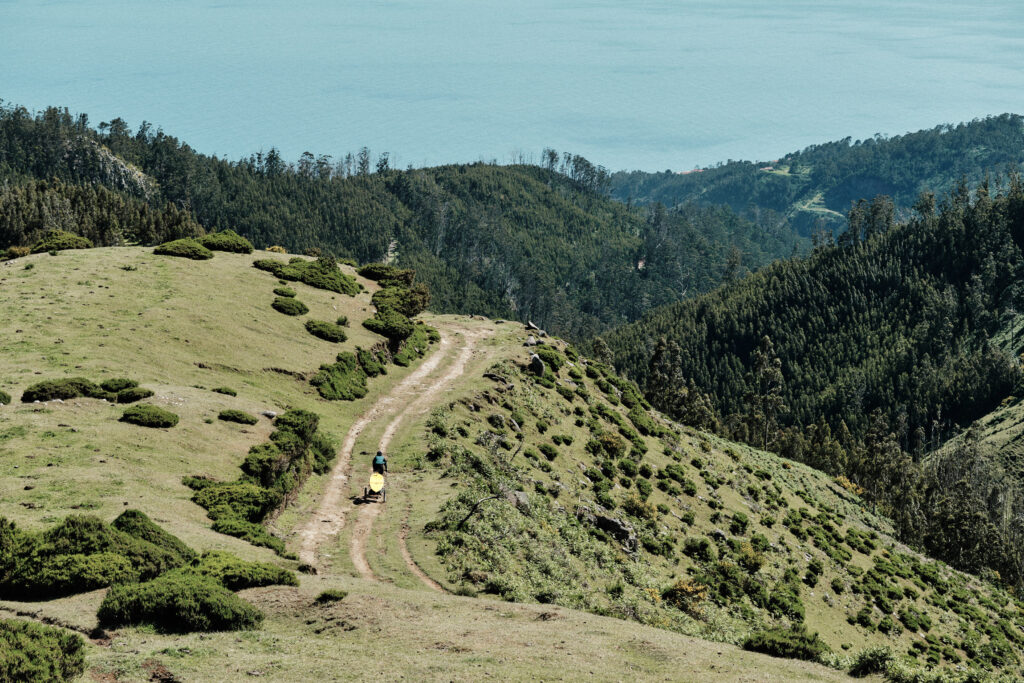
Story • Sami Sauri • Jul 13, 2022
32 Degrees North: Bikes and Waves on Maderia
Sami Sauri explores the best of this Atlantic island by bike and surfboard
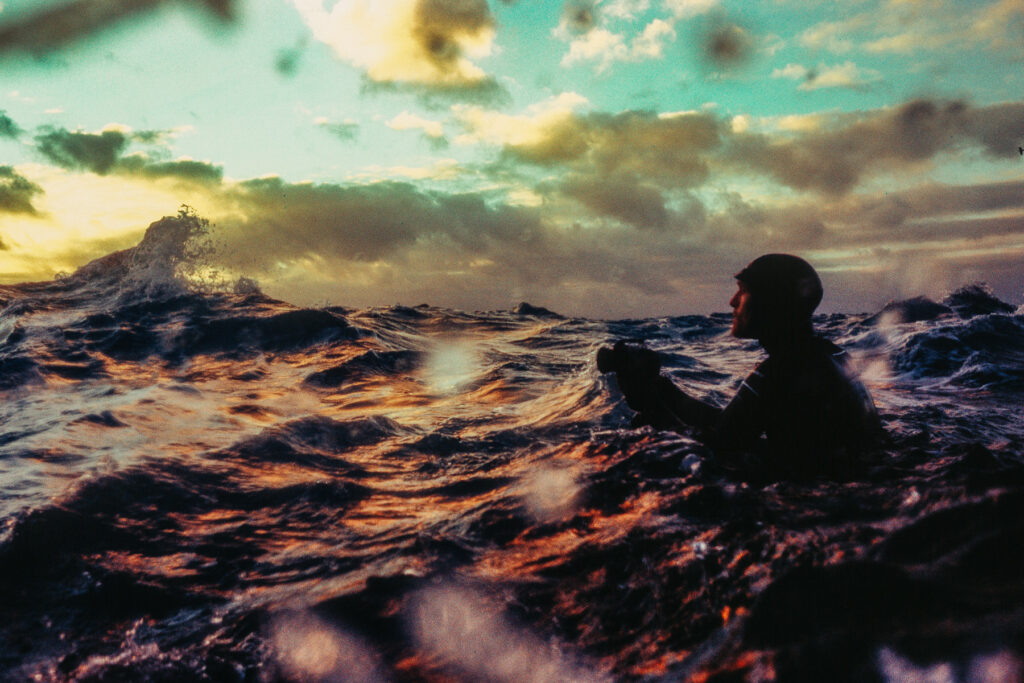
Video • BASE editorial team • Mar 11, 2022
Recollections in Atlantic Reverie
A lifetime of human hearts bewitched by the sea
